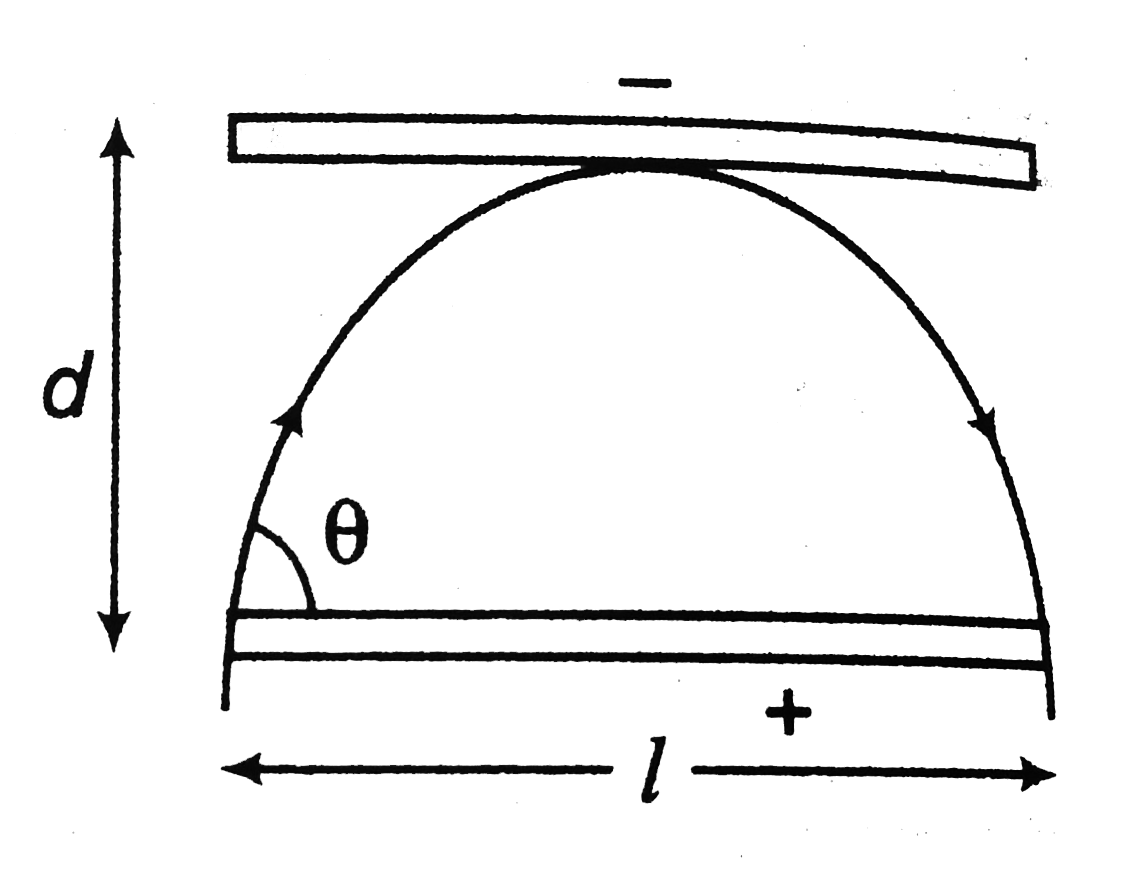A particle having charge that of an electron and mass kg is projected with an initial speed u at the angle to the horizontal from the lower plate of a parallel-plate capacitor as shown in fig. The plates are sufficiently long and have a separation of 2 cm, find the maximum value of the velocity of he particle so that it does not hit the upper plate. Take the electric field between the plates as directed upward.


Resolving the velocity of particle parallel and perpendicular to the plate,
and
Force on the charged particle in the downward direction normal is to the plate Acceleration is , where m is the mass of charged particle. The particle will nothit the upper plate, if the valocity component normal to plate becomes zero before reaching it with where d distance between the plates. therefore the maximum velocity for the particle not to hit the upper plate (for thi ) is
Topper's Solved these Questions
- MISCELLANEOUS VOLUME 3Book:CENGAGE PHYSICSChapter:MISCELLANEOUS VOLUME 3Exercise:Fill in the blanks
Explore 10 Videos
- MISCELLANEOUS VOLUME 3Book:CENGAGE PHYSICSChapter:MISCELLANEOUS VOLUME 3Exercise:True and False Type
Explore 5 Videos
- MISCELLANEOUS VOLUME 3Book:CENGAGE PHYSICSChapter:MISCELLANEOUS VOLUME 3Exercise:Comprehension Type
Explore 94 Videos
- MECHANICAL PROPERTIES OF SOLIDSBook:CENGAGE PHYSICSChapter:MECHANICAL PROPERTIES OF SOLIDSExercise:Question Bank
Explore 4 Videos
- MISCELLANEOUS VOLUME 5Book:CENGAGE PHYSICSChapter:MISCELLANEOUS VOLUME 5Exercise:Integer
Explore 12 Videos
Similar Questions
Knowledge Check
A parallel plate capacitor is charged. If the plates are pulled apart
Athe potential difference increasesBthe capacitance increasesCthe total charge increasesDthe charge and the potential difference remain the sameA positive charge q is given to each plate of a parallel plate air capacitor having plate area A and plate separation d, then
Asince both the plates are identially charged, therefore, capacitance become equal to zeroBenergy stored in the space between the capacitor plates is equal to q2ε0A2Cno charge appears on inner surface of the platesDpotential difference between the plates is equal to 2qdε0AFor a charged parallel plate capacitor shown in the figure, the force experienced by an alpha particle will be :
 Amaximum at CBzero at ACsame at B and CDzero at C
Amaximum at CBzero at ACsame at B and CDzero at C
The plates of a parallel plate capacitance 1.0 F are separated by a distance d =1 cm. Find the plate area .
View SolutionA parallel plate capacitor is constructed with plates of area 0.0280m2 and separation 0.550mm. Find the magnitude of the charge on each plate of this capacitor when the potential between the plates is 20.1V

View SolutionA parallel plate capacitor is charged and then isolated. On increasing the plate separation
View SolutionAn electron enters the region between the plates of a parallel plate capacitor at an angle θ to the plates. The plate width is l, the plate separation is d. The electron follows the path shown just missing the upper plate. Neglect gravity. Then,

View SolutionThe separation between the plates of a charged parallel-plate capacitor is increased. The force between the plates
View Solution